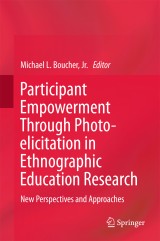Details

Participant Empowerment Through Photo-elicitation in Ethnographic Education Research
New Perspectives and Approaches|
117,69 € |
|
| Verlag: | Springer |
| Format: | |
| Veröffentl.: | 13.10.2017 |
| ISBN/EAN: | 9783319644134 |
| Sprache: | englisch |
Dieses eBook enthält ein Wasserzeichen.
Beschreibungen
<p>This volume gives scholars and students a working knowledge of the procedures, challenges, and benefits of using photo methods in their ethnographic work through studies by researchers who are currently using it. The studies are both examples of exemplary scholarship and serve as tutorials on the procedures and methodological considerations of using this personal, even intimate, method. These eight authors were asked to re-open their carefully packed-away studies, disassemble the methods and the findings, and reflect on the contents. Like looking through old photo albums, these reflective essays allowed us to have new conversations with different audiences. Each chapter contains sections that penetratingly explain the research problem, describe why photo methods were used for the study, elucidate and reflect on the method, summarize the findings, and then examine participant empowerment through the method. This unique structure is specifically designed to be used in masters and doctoral classrooms and with researchers looking for new methods or to strengthen their existing work. The editors and authors believe that using photo-methods can empower participants to become part of the research process. Each author uses photo with the same goal; to create rigorous science that has meaning for the participants.</p>
Acknowledgements.- The Authors.- Section One: Methodological, Critical, and Ethical Considerations.- 1. Introduction - Photo Methods, the Image, and Validity, Michael L. Boucher, Jr.- 2. The Ethics of Visual Research and Participant Empowerment, Kyle Miller.- Section Two: ‘Listening’ to The Silenced.- 3. Auto-driven Photo-elicitation Interviews with Young Deaf People, Dai O’Brien.- 4. Using Photo-Elicitation to Break the Silence, Kharon Grimmet.- 5. Photovoice as a Tool for Understanding Sustainability in the Anthropocene, Deborah Tippins and Sophia (Sun Kyung) Jeong with Purita Bilbao and Lourdes Morano.- Section Three: ‘Listening’ to Kids and Teachers.- 6. Friends, The Club, and The Housing Authority: How Youth Define their Community Through Auto-driven Photo Elicitation, Denisha Jones.- 7. Do you see what I see?: Family-produced Photographs and the Transition to School, Kyle Miller.- 8. Curb my Cynicism: Employing Photo Elicitation to Address the Problem of Research on Bullying, Gerald Walton.- 9.Mediating the Space Between: Using Photo-Elicitation to Prompt Cultural Consciousness-raising, Sarah Mathews.- 10. Interrogating Whiteness: Using Photo-elicitation to Empower Teachers to Talk about Race, Michael L. Boucher, Jr.- Conclusion: Troubling Empowerment.,Michael L. Boucher, Jr.
<p>Assistant Professor of Curriculum and Instruction at Texas State University. He received his Ph.D. from Indiana University and has published on White teachers who build relationships of solidarity with their African American students. He teaches instructional methods, research methods, developmental theory, and diversity classes to graduate students. Before becoming a teacher educator, he taught 9<sup>th</sup> and 10<sup>th</sup> graders to change the world at South High School in Minneapolis, Minnesota.</p>
This volume gives scholars and students a working knowledge of the procedures, challenges, and benefits of using photo methods in their ethnographic work through studies by researchers who are currently using it. The studies are both examples of exemplary scholarship and serve as tutorials on the procedures and methodological considerations of using this personal, even intimate, method. These eight authors were asked to re-open their carefully packed-away studies, disassemble the methods and the findings, and reflect on the contents. Like looking through old photo albums, these reflective essays allowed us to have new conversations with different audiences. Each chapter contains sections that penetratingly explain the research problem, describe why photo methods were used for the study, elucidate and reflect on the method, summarize the findings, and then examine participant empowerment through the method. This unique structure is specifically designed to be used in masters and doctoral classrooms and with researchers looking for new methods or to strengthen their existing work. The editors and authors believe that using photo-methods can empower participants to become part of the research process. Each author uses photo with the same goal; to create rigorous science that has meaning for the participants.
<p>Elucidates several unique techniques for using photo in ethnographic education research</p><p>Provides examples within schools and outside of the school building</p><p>Illustrates how photo techniques empower participants to tell their stories more deeply</p><p>Includes supplementary material: sn.pub/extras</p>
Diese Produkte könnten Sie auch interessieren:

Computer-Based Diagnostics and Systematic Analysis of Knowledge

von: Dirk Ifenthaler, Pablo Pirnay-Dummer, Norbert M. Seel

149,79 €

Religionsunterricht und 'Lebensgestaltung - Ethik - Religionskunde' (LER)

von: Christine Knecht

38,00 €














